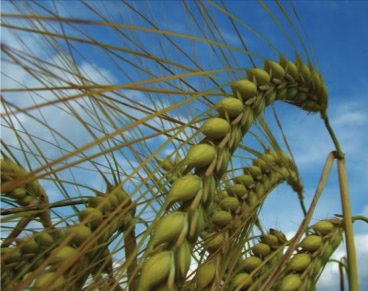
Syngenta is one of the world”s largest plant science companies. It is a leader in crop protection – developing products to control weeds, pests and fungal diseases of plants. Syngenta also breeds a wide range of crops such as wheat and sugar beet.
It has more than 25,000 people working in over 90 countries who are dedicated to its purpose of ‘bringing plant potential to life’. The company provides a support role for its customers too. For example, in 2009 Syngenta trained more than 3.9 million farmers in the developing world in the safe use of crop protection products.

The world’s population is growing rapidly. By 2050, the global population will rise to nine billion people. However, the need for food will increase by 50%. Without the intervention of crop protection, 40% of the world’s food would not exist.
The challenge is to produce more food, with limited land and water resources. Syngenta is focused on developing new varieties of seeds that give higher yields and are more robust. For example, Syngenta’s crop protection and seed products contribute to:
- 5.5 billion garden plants produced a year
- 1 in every 7 tomatoes grown
- 70% of all Scotch whisky.
Syngenta’s product line is the most diverse in its industry. It invests over $1 billion (£0.6 billion) a year in research and development (R&D) and has over 5,000 scientists working to develop new products which help growers to increase crop yields and quality.
This case study shows how R&D is central to building Syngenta’s product range.
New product development
New product development (NPD) is the process which identifies, develops and tests new product opportunities. Firms may develop new products for a number of reasons. These include:
- replacing declining products
- adding to the current portfolio
- filling a gap in the market
- maintaining competitive advantage
- competing with rivals’ products
- attracting new customers.
Some businesses seek to develop new products because they face certain challenges that are specific to the industry in which they operate. The reputation, survival and growth of organisations can depend on new products being brought onto the market.
Finding out what customers want
Syngenta uses market research techniques with growers and farmers to find out about the problems they are facing and the types of solutions they are looking for. One of the challenges facing Syngenta is the growing demand for new crop protection products to increase yields.
Syngenta takes a long term view of the challenges it faces. It has to predict what farmers and agricultural businesses will need in 10 years time and beyond. This involves predicting changes in environmental conditions, e.g. hotter, wetter climates or more widespread droughts. In addition, there is increasing customer demand. Syngenta’s research centres use an ongoing cycle of testing new chemicals on soils and plants in conditions that reflect particular countries or climate zones. New products emerge from a combination of market-orientated and product-orientated innovation.
Syngenta seeks to provide a stream of new products based on emerging technologies. These provide innovation in crop protection as well as new varieties of crops. At the same time, existing varieties of established crops need to be protected from disease and pests. Syngenta has therefore created treatments to protect the crops, as well as developing new varieties of seeds that have in-built resistance.
The R&D process
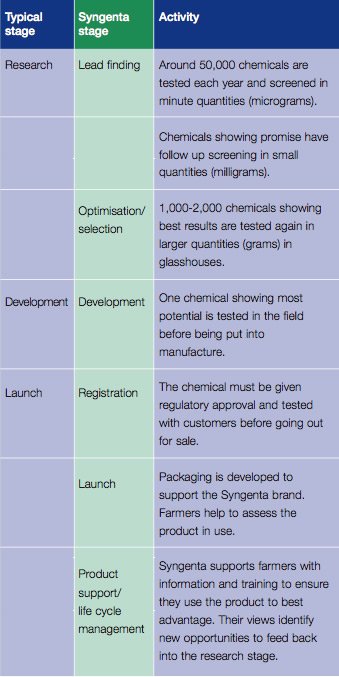
Syngenta’s research and development process follows specific stages. In some industries, product testing occurs only at the end of the process before launch. With Syngenta products, testing (screening) happens at every stage of the process.
It is necessary to evaluate the potential of every chemical in this long and expensive development process. It takes Syngenta scientists up to 10 years to develop a new crop protection product. The company typically spends around $200 million (£120 million) on developing a new product.
Research
Research is at the heart of Syngenta”s activities and enables it to discover new products with outstanding performance in the field. Syngenta”s scientists carry out research to identify active ingredients that:
- are effective
- are specific to solving crop-related problems
- have a novel mode of action i.e. how the chemical works
- are safe.
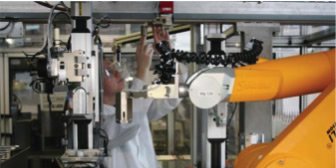
Syngenta’s research process is like a funnel: thousands of chemical compounds go into the process but only a few successful ones come out the other end. Out of every 100,000 compounds examined, only one or two will make it into production as fully established products.
Identifying compounds
To help speed up the process of identifying appropriate active ingredients (‘lead finding’), Syngenta has a collection of about two million different chemical compounds. These have the potential to develop into active products. Its scientists test about 50,000 chemicals each year to assess their biological activity and identify the most promising chemical compounds for further research.
Screening and testing
Syngenta uses the latest technology to make procedures more efficient. Part of the screening of chemical compounds is carried out by fully-automated robots. This type of technology can prepare and formulate hundreds of potential ingredients every day, at far greater speeds than scientists can achieve. This gives high throughput with lower costs.
The system helps Syngenta scientists by freeing up their time to be more innovative and productive. The research phase also includes simulating different growing conditions in field trials and in glasshouses. These allow scientists to see how the chemical behaves over time.
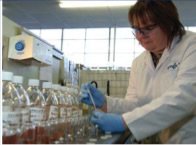
At the chemical stage it costs about £100 per test. A field trial of a full product might be as much as £100,000 or more. New computer software can assess soil conditions in fields. This helps scientists to understand how much water is needed for growing the crop.
Development
Development involves turning research into useful products.
Product specification
For a chemical to progress from the research phase into development it must meet specified criteria. Most importantly, will the resulting product meet customer requirements?
Other criteria might include: can the product be manufactured in large quantities and profitably? How long is the product life cycle expected to be? The answers to this type of question form a product brief which outlines what is required of the new product. A specification follows which details the features, benefits and costs of the venture.
Success stories
One product that made it through all the stages of research is Amistar. This has now become the world’s leading fungicide which has been developed to destroy the growth of harmful fungi on plants.

Gallant is Syngenta’s newest high-performing wheat variety. It has excellent bread-making qualities. The brief for the new product was to breed an improved winter wheat variety to give higher yields and superior grain quality to make it suitable for milling. A specification was created which set out the features the new wheat needed to have (for example protein content, quality, consistency, disease resistance, practical to grow), as well as the benefits and financial costs of development.
Syngenta scientists used different breeding combinations to find the best product. Gallant was tested in field trials by Syngenta and, following registration and protection, was also trialled by independent organisations who have officially recommended it to farmers and end users.
Meeting standards
New products also need to meet strict EU and US standards in order to be sold across the world. Syngenta carries out testing at various points of the development cycle. It needs to assess whether a new chemical compound:
- has the best formulation
- works effectively in real situations, not just in the laboratory
- has no adverse effects on humans or the environment.
Stewardship
Once a product is on the market, Syngenta still has a role to play in product stewardship. This means it carries out an ongoing assessment of whether the product remains effective and environmentally-friendly in use for both humans and the land.
For example, with Amistar it was necessary to first research the impact that the fungicide had on local environments in which the product was originally trialled. Around 40% of Syngenta’s research and development costs are spent on meeting regulatory and safety requirements.
Challenges and benefits of R&D
Challenges
R&D plays a huge role in Syngenta’s business growth. However, there are a number of challenges involved in any research and development activity:
- High costs – Syngenta spent $1 billion on R&D in 2009.
- Long timescales – it typically takes Syngenta ten years to bring a new product to market.
- Uncertain outcomes – there are always uncertainties about whether the product will meet the original brief and customer requirements. For example, pests may develop resistance to the product over time.
- Difficulties in anticipating how conditions will change in the market and whether customer needs will change during the long R&D process. Competitors may come up with a rival product that is just as effective.
Benefits
However, businesses gain considerable benefits from investing in research and development:
- Unique products – these can give businesses a unique selling point (USP). They can then acquire patents for these products. The patent is a legal protection that prevents other companies from copying them.
- Competitive advantage – through R&D Syngenta is able to build advantage over its competitors by bringing innovative products to the market.
- Long term income – once a product has been developed it can generate a strong stream of profits for many years.
- Ongoing research also leads to new opportunities – researchers cannot always anticipate what the results of their research will be. Often chance discoveries open up whole new channels of research.
- Enhanced reputation – engaging in research helps to build Syngenta”s brand. Farmers and growers are more likely to trust a company with a strong scientific research and development base.
Technology exchange
In order to enhance its research base, Syngenta also participates in exchanging technology with other research organisations. Although patents protect a business’ intellectual property, they can slow down the speed of research. By agreeing to exchange technology with similarly placed organisations, Syngenta and the agrichemical industry keep R&D moving forward and gain mutual benefit.
Conclusion
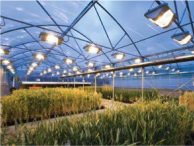
The business environment and customers’ needs are constantly changing. Science-based organisations in particular need to invest in research and development to help them respond to these changes. Although this is a costly and time-consuming process, R&D can result in the development of innovative new products and services. This in turn can lead to greater profits and enhanced reputation.
Syngenta’s focus on plant science has allowed it to develop new products which address world demand. The research and development that it has carried out has led to the creation of new products such as the fungicide Amistar and Gallant winter wheat. By investing huge sums of money into R&D, Syngenta provides solutions to help farmers.
 Feeding and fuelling the world through technology (MP3)
Feeding and fuelling the world through technology (MP3) 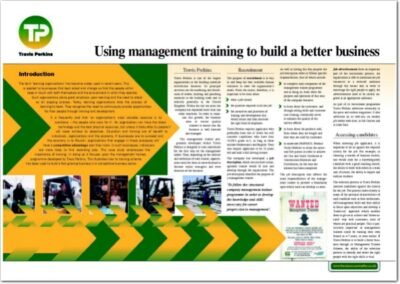 Using management training to build a better business (PDF)
Using management training to build a better business (PDF) 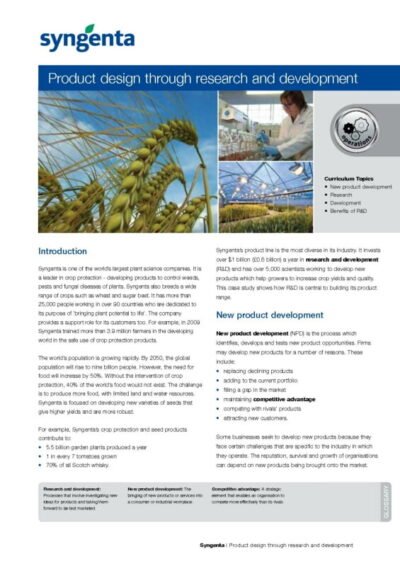 Product design through research and development (PDF)
Product design through research and development (PDF) 